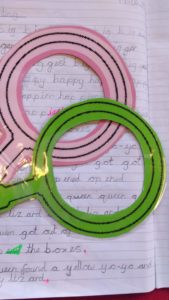I don’t remember where I first heard the ‘lens’ metaphor (probably my PG Cert in Professional Education, 2007) but I do remember being very confused by it initially. Others referred to using a “different lens” and I just nodded – as I’d no idea what they meant! But once I’d read more – the idea clicked – and it’s a really useful metaphor – but only once someone has clearly explained what it means (and I’m not sure this has happened for all the people I support to understand “reflective”).
My current understanding is that the ‘lens’ metaphor is based on the concept that vision is altered as you look through a lens, for example through glasses or a magnifying glass – depending on the lens used – text that was unreadable can become clear or distant objects become sharp. Metaphorically this is the idea that applying a ‘lens’ can allow you to ‘see’ something that was previously invisible to you. Like most metaphors you can only stretch it so far – the ‘lens’ you apply are not made of glass rather they are other ways of understanding such as from the view of a particular theory. For example Brookfield (2017) offers four lenses available to any teacher: students’ eyes, colleagues’ perceptions, personal experience, and theory. The part of the metaphor the that really confused me initially was the idea that that the ‘lens’ is not a physical distortion as through glass or plastic but rather a mental re-framing informed by a new perspective and can come from different sources as Brookfield (2017) suggests. I think talking about the ‘lens’ metaphor would be useful with my CMALT group, particularly if I give the examples Brookfield (2017) offers because it can help you to consider different view points and to think about integrating literature and personal experience. To extend the metaphor – the ‘lens’ is a tool that can be turned in different directions and used for investigation – its less passive than that mirror for reflection – it encourages proactive investigation.
While searching to find more about the origins of the lens metaphor, I found McKnight & Whitburn (2017) which critiques the ‘lens’ metaphor and more broadly the work of Lakoff and Johnson (2003). McKnight & Whitburn (2017) critique the lens metaphor within the broader visual metaphor observing that the term ‘blind’ is used in educational theory to refer to something not known as in ‘blind spot’ they refer to this as “the troubling construction of augmented vision as knowledge and blindness as ignorance” and point out that that is ablist, based on the assumption that to be able bodied is positive while disability is negative. (V1)
Reading this has made me question if I need to investigate the assumptions in metaphor more thoroughly to consider how inclusive they are. (V1)

When searching for literature on this area I also found a paper (Saban 2006) on the function of metaphor in education which includes ideas on using metaphor as a way to reflect on professional development. This includes a study by Hoban (2000) where trainee teachers were encouraged to reflect on their class experiences identify metaphors to “represent their conceptualizations of teaching and learning” for which one student came up with a playground metaphor. I like the idea that rather than using pre formed metaphors which may or may not have meaning for the students, such as mirrors or lens, in this exercise the students form there own analogies – which encourages them to think deeply about how they view their practice. It may also make them more questioning of the use of metaphor when they meet it in the education literature. (V3)
This is inspiring me to think of ways to share my interest in metaphor with my cohort and see if this approach would help them reflect on their own professional practice? Could I include an activity like the one described above? Perhaps this could be a way to open up a discussion on what ‘reflection’ is in professional practice?
References:
Brookfield, S. (2017) Becoming a Critically Reflective Teacher. 2nd Ed Jossey-Bass (Kindle Edition)
Lakoff, G. and Johnson, M. (2003) Metaphors We Live By. The University of Chicago Press, Chicago.
McKnight L. & Whitburn, B. (2017) The fetish of the lens: persistent sexist and ableist metaphor in education research. International Journal of Qualitative Studies in Education, 30:9, 821-831, DOI: 10.1080/09518398.2017.1286407
Saban, A (2006) Functions of Metaphor in Teaching and Teacher
Education: A review essay, Teaching Education, 17:4, 299-315, DOI: 10.1080/10476210601017386